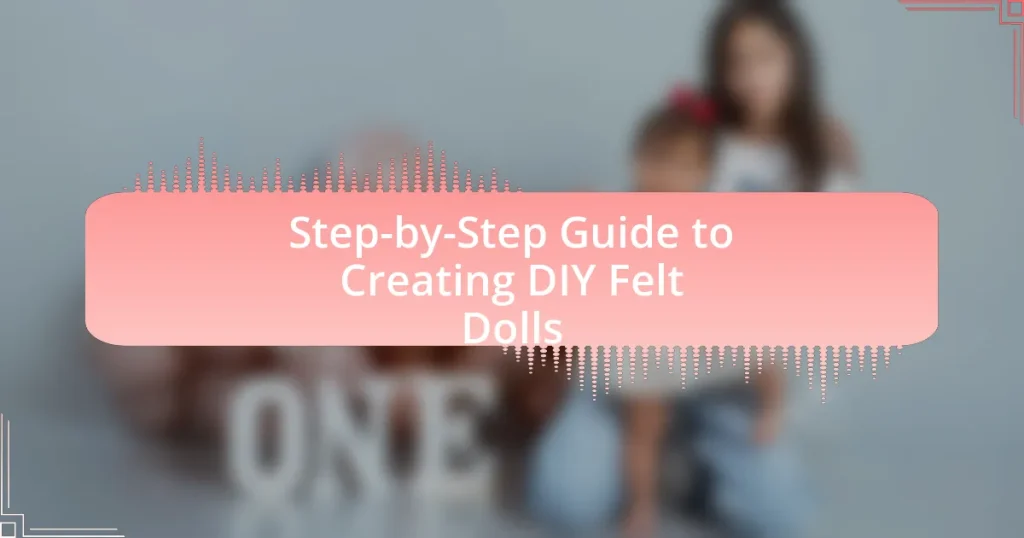DIY Felt Dolls are handcrafted figures made from felt fabric, allowing for customization in size, shape, and features through various sewing techniques. This article provides a comprehensive step-by-step guide on creating these dolls, detailing essential materials, skills required, and the differences between DIY Felt Dolls and traditional dolls. It covers the process of designing, assembling, and personalizing dolls, while also addressing common challenges and mistakes beginners should avoid. Additionally, the article highlights the benefits of crafting DIY Felt Dolls, including enhanced creativity and improved mental well-being.

What are DIY Felt Dolls?
DIY Felt Dolls are handcrafted figures made from felt fabric, designed and assembled by individuals using various sewing techniques. These dolls can be customized in terms of size, shape, and features, allowing for personal expression and creativity. The process typically involves cutting felt into desired shapes, stitching or gluing pieces together, and adding embellishments like buttons or embroidery to enhance their appearance. The popularity of DIY Felt Dolls stems from their versatility and the ease of working with felt, which is a forgiving material for beginners and experienced crafters alike.
How are DIY Felt Dolls different from other types of dolls?
DIY Felt Dolls differ from other types of dolls primarily in their construction material and the creative process involved. Unlike traditional dolls made from plastic or porcelain, DIY Felt Dolls are crafted from felt, which allows for a softer texture and greater flexibility in design. This material choice enables crafters to easily customize shapes, colors, and features, fostering a hands-on, personalized approach to doll-making. Additionally, the DIY aspect emphasizes individual creativity, as each doll can be uniquely designed and assembled, contrasting with mass-produced dolls that lack this personal touch.
What materials are typically used in making DIY Felt Dolls?
The materials typically used in making DIY Felt Dolls include felt fabric, embroidery floss, stuffing, and sewing needles. Felt fabric serves as the primary material for the doll’s body and features, available in various colors and thicknesses. Embroidery floss is used for stitching details and embellishments, while stuffing provides volume and shape to the doll. Sewing needles are essential for assembling the components together. These materials are commonly chosen for their accessibility and ease of use in crafting projects.
What skills are necessary to create DIY Felt Dolls?
To create DIY Felt Dolls, essential skills include sewing, pattern making, and basic crafting techniques. Sewing skills are crucial for stitching felt pieces together securely, while pattern making allows for the design of unique doll shapes and features. Basic crafting techniques, such as cutting, gluing, and embellishing, enhance the overall aesthetic and functionality of the dolls. Mastery of these skills enables crafters to produce high-quality felt dolls that are both visually appealing and durable.
Why should you consider making DIY Felt Dolls?
Making DIY Felt Dolls is beneficial because it fosters creativity and enhances fine motor skills. Engaging in this craft allows individuals to express their artistic vision while developing hand-eye coordination and dexterity through cutting, sewing, and assembling felt pieces. Additionally, studies show that crafting activities can improve mental well-being by reducing stress and promoting mindfulness, making the process not only enjoyable but also therapeutic.
What are the benefits of crafting your own dolls?
Crafting your own dolls offers numerous benefits, including enhanced creativity, personalization, and emotional connection. Engaging in the doll-making process allows individuals to express their artistic skills and imagination, resulting in unique creations that reflect personal style. Additionally, handmade dolls can be tailored to specific preferences, such as size, color, and features, making them more meaningful than mass-produced alternatives. Research indicates that crafting activities can also improve mental well-being by reducing stress and promoting mindfulness, as evidenced by studies showing that creative hobbies lead to increased happiness and satisfaction.
How can DIY Felt Dolls be personalized?
DIY Felt Dolls can be personalized by customizing their features, clothing, and accessories. This can include selecting specific colors for the felt, adding unique facial expressions, and incorporating personal items like miniature objects or symbols that hold significance to the creator or recipient. Personalization can also involve stitching names or initials onto the dolls, which adds a distinctive touch. These methods enhance the emotional connection and uniqueness of each doll, making them special gifts or keepsakes.

What are the essential steps in creating DIY Felt Dolls?
The essential steps in creating DIY Felt Dolls include selecting materials, designing the doll, cutting the felt, assembling the pieces, and adding details. First, gather felt sheets, scissors, needle, thread, and stuffing. Next, sketch a design for the doll to determine its shape and features. After that, cut the felt according to the design, ensuring all pieces are accurately shaped. Then, assemble the cut pieces by sewing or gluing them together, starting with the body and adding limbs and head. Finally, embellish the doll with details such as facial features, clothing, and accessories to complete the project. These steps provide a structured approach to crafting felt dolls effectively.
How do you gather materials for DIY Felt Dolls?
To gather materials for DIY Felt Dolls, start by identifying essential supplies such as felt sheets, scissors, needle and thread, stuffing, and embellishments like buttons or fabric markers. These materials can be sourced from craft stores, online retailers, or repurposed from existing items at home. Craft stores typically offer a variety of felt colors and textures, while online platforms provide convenience and often a wider selection. Additionally, using household items like old clothing for fabric can be a cost-effective way to gather materials. This approach is validated by the common practice among crafters to utilize readily available resources to minimize expenses while maximizing creativity.
What types of felt are best for doll-making?
The best types of felt for doll-making are wool felt and polyester felt. Wool felt is favored for its durability, softness, and ability to hold shape, making it ideal for detailed features and intricate designs. Polyester felt, on the other hand, is more affordable, comes in a wide range of colors, and is easy to work with, making it suitable for beginners and larger projects. Both types provide a good balance of quality and versatility, essential for creating appealing and long-lasting felt dolls.
What tools are needed for crafting DIY Felt Dolls?
To craft DIY Felt Dolls, essential tools include felt fabric, scissors, a needle, and thread. Felt fabric serves as the primary material for creating the doll’s body and features, while scissors are necessary for cutting the felt into desired shapes. A needle and thread are required for stitching the pieces together, ensuring durability and structure. Additionally, fabric glue can be useful for securing smaller elements or embellishments. These tools are fundamental for successfully completing the crafting process.
What is the process of designing a DIY Felt Doll?
The process of designing a DIY Felt Doll involves several key steps: conceptualization, pattern creation, material selection, assembly, and finishing touches. First, conceptualization requires deciding on the doll’s character, size, and features, which guides the overall design. Next, pattern creation involves sketching the doll’s components, such as the body, limbs, and clothing, ensuring they fit together properly. Material selection includes choosing appropriate felt colors and textures, as well as additional embellishments like buttons or embroidery thread. Assembly follows, where the cut felt pieces are sewn or glued together, forming the doll. Finally, finishing touches involve adding details like facial features and accessories, enhancing the doll’s personality. This structured approach ensures a cohesive and visually appealing final product.
How do you create a pattern for your doll?
To create a pattern for your doll, start by sketching the doll’s design on paper, ensuring to include all necessary dimensions and details. This initial sketch serves as a blueprint, allowing you to visualize the final product. Next, transfer the sketch onto pattern paper, using a ruler for precise measurements and ensuring that each piece corresponds to the doll’s body parts, such as the head, arms, and legs. After cutting out the pattern pieces, you can test the fit by pinning them together with fabric to make adjustments as needed. This method is effective because it allows for modifications before finalizing the design, ensuring a well-fitted doll.
What considerations should be made for doll proportions?
Doll proportions should be carefully considered to ensure aesthetic appeal and functionality. Key factors include the scale of the doll in relation to its intended use, such as play or display, as well as the balance between head, body, and limb sizes to create a visually pleasing silhouette. For instance, a common proportion for a stylized doll is a head that is one-third the height of the body, which enhances expressiveness and character. Additionally, the proportions should accommodate the materials used; felt, for example, may require slightly larger dimensions to maintain structural integrity. These considerations are essential for achieving a well-crafted and appealing final product.
How do you assemble a DIY Felt Doll?
To assemble a DIY Felt Doll, first cut out the doll’s body parts from felt, including the front, back, arms, and legs. Next, sew or glue the front and back pieces together, leaving an opening for stuffing. After that, fill the doll with stuffing material until it reaches the desired firmness. Finally, close the opening with stitches or glue, and add any additional features like facial details or clothing by sewing or gluing them onto the doll. This method ensures a sturdy and visually appealing felt doll.
What techniques are used for cutting and sewing felt?
Techniques used for cutting and sewing felt include using sharp scissors for precise cutting and employing a sewing machine or hand stitching for assembly. Sharp scissors ensure clean edges, which is crucial for the overall appearance of the felt dolls. When sewing, a sewing machine can provide speed and uniformity, while hand stitching allows for more control and detail, especially in intricate areas. Additionally, using a straight stitch or a zigzag stitch can enhance durability and flexibility in the seams, making the finished product more resilient.
How do you attach features like eyes and hair?
To attach features like eyes and hair to DIY felt dolls, sew or glue them securely onto the doll’s head. For eyes, use buttons or felt circles, ensuring they are evenly spaced and securely fastened to avoid detachment. For hair, cut strands of yarn or felt, then stitch or glue them in place, layering as needed for a fuller appearance. This method is effective as it provides durability and a professional finish, commonly used in crafting felt dolls.

What are some common challenges in making DIY Felt Dolls?
Common challenges in making DIY felt dolls include achieving precise cutting, ensuring proper stitching, and selecting appropriate materials. Precise cutting is crucial because uneven edges can affect the overall appearance and assembly of the doll. Proper stitching is essential to maintain durability and shape; inconsistent tension can lead to fraying or gaps. Additionally, selecting the right materials, such as felt thickness and type of thread, can impact the final product’s quality and longevity. These challenges are frequently encountered by crafters, as evidenced by numerous online forums and crafting communities where users share their experiences and solutions.
What mistakes should beginners avoid when creating DIY Felt Dolls?
Beginners should avoid using low-quality felt when creating DIY Felt Dolls, as it can lead to fraying and poor durability. High-quality felt is more resilient and easier to work with, ensuring that the finished doll maintains its shape and appearance over time. Additionally, beginners often neglect to plan their designs, which can result in uneven proportions and awkward features. Taking the time to sketch out designs and measure pieces accurately can significantly improve the final product. Another common mistake is using inappropriate adhesives; beginners should opt for fabric glue instead of craft glue, as fabric glue is specifically designed for textile applications and provides a stronger bond. Lastly, beginners frequently overlook the importance of securing all pieces properly, which can lead to parts coming apart during play. Ensuring that all elements are stitched or glued securely will enhance the doll’s longevity and usability.
How can you troubleshoot common sewing issues?
To troubleshoot common sewing issues, first identify the specific problem, such as thread bunching, skipped stitches, or fabric puckering. For thread bunching, rethread the machine and check the tension settings, as improper tension can cause this issue. If skipped stitches occur, ensure the needle is appropriate for the fabric type and replace it if necessary, as a dull or damaged needle can lead to this problem. For fabric puckering, use a walking foot or adjust the stitch length, as these adjustments can help manage fabric movement during sewing. These troubleshooting steps are effective because they address the root causes of common sewing problems, ensuring a smoother sewing experience.
What are the best practices for maintaining doll quality?
To maintain doll quality, it is essential to store dolls in a cool, dry place away from direct sunlight to prevent fading and deterioration. Regular cleaning with a soft, damp cloth helps remove dust and dirt, while avoiding harsh chemicals preserves the fabric and materials. Additionally, using a protective spray designed for fabric can enhance durability. Proper handling, such as avoiding excessive pulling or stretching of limbs, ensures structural integrity. These practices are supported by guidelines from textile preservation experts, emphasizing the importance of environmental control and gentle care for longevity.
How can you enhance your DIY Felt Doll-making skills?
To enhance your DIY Felt Doll-making skills, practice consistently by creating a variety of doll designs and experimenting with different techniques. Engaging in regular practice allows you to refine your sewing, cutting, and assembling skills, which are crucial for producing high-quality felt dolls. Additionally, studying tutorials and patterns from experienced crafters can provide new insights and methods, further improving your craftsmanship. For instance, resources like online crafting communities and instructional videos can offer step-by-step guidance and innovative ideas that can elevate your work.
What resources are available for learning advanced techniques?
Online platforms such as Craftsy and Skillshare offer courses specifically focused on advanced techniques for creating DIY felt dolls. These platforms provide video tutorials and community forums where users can share their experiences and tips. Additionally, books like “Felt Doll Making” by Kendra W. and “The Art of Felt Dolls” by Anna M. serve as comprehensive resources, detailing intricate methods and patterns. Furthermore, YouTube channels dedicated to crafting often feature advanced felt doll techniques, providing visual guidance and step-by-step instructions.
How can community engagement improve your crafting experience?
Community engagement can significantly enhance your crafting experience by providing access to diverse ideas, techniques, and support. Engaging with a crafting community allows individuals to share knowledge, which can lead to improved skills and creativity in making DIY felt dolls. For instance, participating in workshops or online forums can expose crafters to new patterns and methods that they may not have encountered independently. Additionally, collaboration with others fosters motivation and accountability, encouraging consistent practice and exploration of new projects. Research indicates that social interaction in crafting communities can lead to increased satisfaction and a sense of belonging, which further enriches the crafting journey.
What are some tips for successful DIY Felt Doll creation?
To successfully create DIY felt dolls, start by selecting high-quality felt and sharp scissors for precise cutting. Using a sewing machine or hand-stitching techniques can enhance durability and detail in your dolls. Additionally, incorporating a variety of colors and textures will add visual interest and uniqueness to each doll. Following patterns or templates can provide structure, while personalizing features like facial expressions and clothing can make each doll special. Research shows that engaging in crafting activities, such as felt doll creation, can improve fine motor skills and foster creativity, making it a beneficial hobby.


